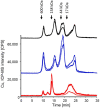Insights into copper sensing and tolerance in Pneumocystis species
- PMID: 38812685
- PMCID: PMC11133566
- DOI: 10.3389/fmicb.2024.1383737
Insights into copper sensing and tolerance in Pneumocystis species
Abstract
Introduction: Pneumocystis species are pathogenic fungi known to cause pneumonia in immunocompromised mammals. They are obligate to their host, replicate extracellularly in lung alveoli and thrive in the copper-enriched environment of mammalian lungs. In this study, we investigated the proteome of Pneumocystis murina, a model organism that infects mice, in the context of its copper sensing and tolerance.
Methods and results: The query for copper-associated annotations in FungiDB followed by a manual curation identified only 21 genes in P. murina, significantly fewer compared to other clinically relevant fungal pathogens or phylogenetically similar free-living fungi. We then employed instrumental analyses, including Size-Exclusion Chromatography Inductively Coupled Plasma Mass Spectrometry (SEC-ICP-MS), Immobilized Metal Affinity Chromatography (IMAC), and Liquid Chromatography-Tandem Mass Spectrometry (LC-MS/MS), to isolate and identify copper-binding proteins from freshly extracted organisms, revealing 29 distinct cuproproteins. The RNA sequencing (RNA-seq) analysis of P. murina exposed to various CuSO4 concentrations at three temporal intervals (0.5, 2, and 5 h) indicated that significant gene expression changes occurred only under the highest CuSO4 concentration probed (100 μM) and the longest exposure duration (5 h). This stimulus led to the upregulation of 43 genes and downregulation of 27 genes compared to untreated controls. Quantitative PCR (qPCR) confirmed the expression of four out of eight selected upregulated genes, including three assumed transcription factors (PNEG_01236, PNEG_01675, and PNEG_01730) and a putative copper transporter (PNEG_02609). Notably, the three applied methodologies - homology-based annotation, SEC-ICP-MS/IMAC/LC-MS/MS, and RNA-seq - yielded largely distinct findings, with only four genes (PNEG_02587, PNEG_03319, PNEG_02584, and PNEG_02989) identified by both instrumental methods.
Discussion: The insights contribute to the broader knowledge of Pneumocystis copper homeostasis and provide novel facets of host-pathogen interactions for extracellular pathogens. We suggest that future studies of Pneumocystis pathogenicity and copper stress survival should consider the entire spectrum of identified genes.
Keywords: Pneumocystis; copper sensing; copper tolerance; cuproproteins; host-pathogen interaction; metalloproteome.
Copyright © 2024 Porollo, Sayson, Ashbaugh, Rebholz, Landero Figueroa and Cushion.
Conflict of interest statement
The authors declare that the research was conducted in the absence of any commercial or financial relationships that could be construed as a potential conflict of interest. The author(s) declared that they were an editorial board member of Frontiers, at the time of submission. This had no impact on the peer review process and the final decision.
Figures




Similar articles
-
Comparative genomics of pneumocystis species suggests the absence of genes for myo-inositol synthesis and reliance on inositol transport and metabolism.mBio. 2014 Nov 4;5(6):e01834. doi: 10.1128/mBio.01834-14. mBio. 2014. PMID: 25370490 Free PMC article.
-
Extracellular vesicles from Pneumocystis carinii-infected rats impair fungal viability but are dispensable for macrophage functions.Microbiol Spectr. 2024 Feb 6;12(2):e0365323. doi: 10.1128/spectrum.03653-23. Epub 2024 Jan 18. Microbiol Spectr. 2024. PMID: 38236033 Free PMC article.
-
Pneumocystis murina colonization in immunocompetent surfactant protein A deficient mice following environmental exposure.Respir Res. 2009 Feb 19;10(1):10. doi: 10.1186/1465-9921-10-10. Respir Res. 2009. PMID: 19228388 Free PMC article.
-
Pneumocystis Mating-Type Locus and Sexual Cycle during Infection.Microbiol Mol Biol Rev. 2021 Aug 18;85(3):e0000921. doi: 10.1128/MMBR.00009-21. Epub 2021 Jun 16. Microbiol Mol Biol Rev. 2021. PMID: 34132101 Free PMC article. Review.
-
Pneumocystis carinii pneumonia: the status of Pneumocystis biochemistry.Int J Parasitol. 1998 Jan;28(1):65-84. doi: 10.1016/s0020-7519(97)00179-3. Int J Parasitol. 1998. PMID: 9504336 Review.
Cited by
-
Extracellular Vesicle-Mediated Delivery of Genetic Material for Transformation and CRISPR/Cas9-based Gene Editing in Pneumocystis murina.bioRxiv [Preprint]. 2025 Jun 17:2025.06.17.660080. doi: 10.1101/2025.06.17.660080. bioRxiv. 2025. PMID: 40667333 Free PMC article. Preprint.
References
Grants and funding
LinkOut - more resources
Full Text Sources

